How To Powerlift With Scoliosis (Complete Guide) | PowerliftingTechnique.com (original) (raw)
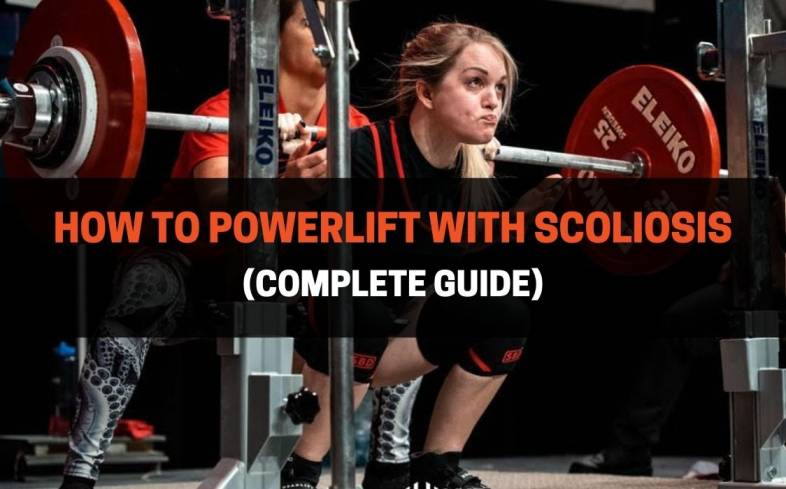
If you think that you can’t become a powerlifter or that you should stay away from all forms of resistance training due to having scoliosis in your spine, keep this in mind: Usain Bolt – the fastest human being ever in humanity’s existence – has scoliosis. And it’s not exactly a minor case of scoliosis, either (it’s greater than 40 degrees). So, chances are that if he can sprint, you can lift.
To powerlift safely and effectively with scoliosis, you need to know how your spine differs from a typical one, learn variations of lifts that work best for you, develop good spinal hygiene, keep your hips healthy and find a healthcare practitioner willing to work with you based on your needs.
While every person’s individual condition, needs, and abilities are going to differ, scoliosis generally isn’t nearly as serious or debilitating as the average person may think it is, so long as it’s not on the extreme end and is addressed and monitored properly.
If you’re wanting to give yourself as much success as possible, here’s how you’ll want to attack powerlifting if you have scoliosis:
- Learn the basics of scoliosis
- Find a healthcare professional willing to work with you
- Get familiar with exercise variations for each of the lifts
- Become an expert on your own spine
- Develop exceptional spinal hygiene
- Keep your hips healthy
I’m going to cover each of these in more detail below, but first I want to share with you some examples of powerlifters who have scoliosis.
Table of Contents
Toggle
- Powerlifters With Scoliosis: 3 Examples
- Learning The Basics Of Scoliosis
- Find A Healthcare Professional Willing To Work With You
- Get Familiar With Exercise Variations For Each Of The Lifts
- Become An Expert On Your Own Spine
- Develop Exceptional Spinal Hygiene
- Keep Your Hips Healthy
- Final Thoughts
- About The Author
- References
Powerlifters With Scoliosis: 3 Examples
I asked around our PowerliftingTechnique.com community if anyone had scoliosis and several people stepped forward with their experiences. Here are just 3 examples of powerlifters who have been training and competing successfully with scoliosis.
Sarah Strickland
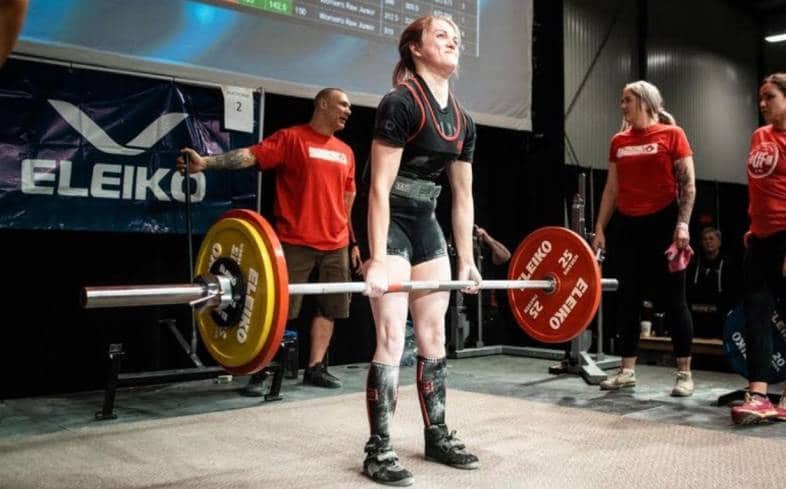
“I have a lot of professionals involved in my training – an extremely knowledgeable massage therapist/kinesiologist and osteopath. They often given me stretches and exercises that focus on strengthening my lower back. Even before powerlifting, there has been a great emphasis on core work since dealing with scoliosis. Physiotherapists would always provide me with core strengthening exercises. Strengthening my core has been essential for me since powerlifting as well. In an average person, core work is so important when powerlifting but for myself, I really feel back pain when I don’t implement this “extra” work. In terms of getting into powerlifting with scoliosis, my advice would be to just try it. Build and strengthen your core. Implement core exercises into your programming. If you feel pain or discomfort, seek the right help and I’m sure there is a way to work through it.”
Antii Krikkula
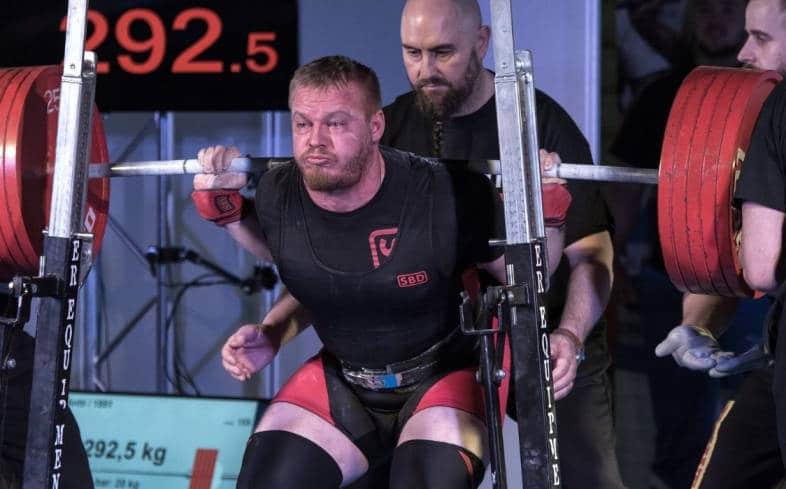
Scoliosis does not need to weigh you down. Learn what things aggravate your back and work around them. I was told by a doctor scoliosis would affect me for the rest of my life. Well, here I am, squatting and deadlifting over 300 kilos.
Jody McPeak
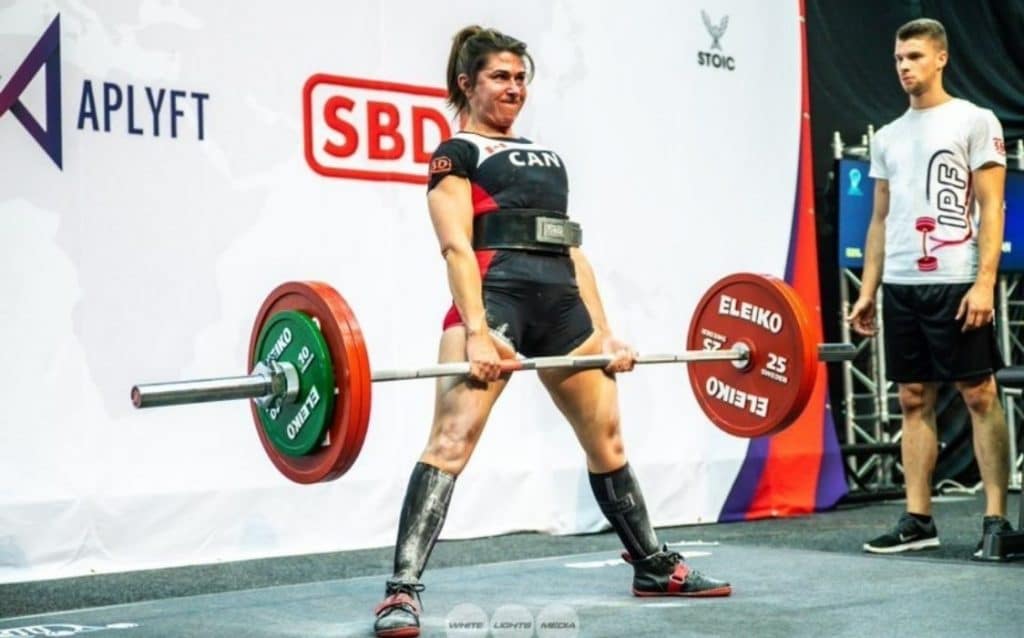
I feel we all have some asymmetry to a degree and it shouldn’t be a roadblock in persevering with powerlifting. I manage scoliosis by realizing I have some weaknesses that seem to show up more on my left side. Knowing this I try to recognize that my dominant side can compromise my technique if I don’t strengthen unilaterally some of those weaker areas. Focusing on proper technique each & every rep, and working on mobility each session and strength of each side with accessories. I think it’s honestly approaching training with a mature patient attitude towards slowly getting stronger in your main lifts but including a realistic program that has some mobility and unilateral accessory work on certain areas. That would be for if you have scoliosis or not so I never look at this as a hindrance.
Learning The Basics Of Scoliosis
Having a basic understanding of any orthopedic condition (a condition involving the muscles, bones or joints) can help to ease any underlying uncertainty or lack of understanding you may have, which can help give peace of mind and ease any anxiety or apprehensions you may have when considering powerlifting, or lifting in general. It will also help keep you safer in the long run. So, learning the basics of this condition is the perfect starting point.
Normally, if viewing a person from straight ahead, the spine has specific curves in forwards and backwards directions (known as kyphotic and lordotic curves), but a spine with scoliosis has a sideways curvature in addition to also having the normal forwards and backwards curves.
The extent of this sideways curvature can vary immensely from one condition of scoliosis to another and the location in the spine where the sideways curving takes place can also vary. The scoliotic curvature can either be stable (meaning it won’t progress any further) or progressive in that the curve can worsen as time goes on.
You haven’t done anything wrong in order to get scoliosis – it’s largely unknown as to why it happens (known as an idiopathic onset) and it tends to affect males more than females.
No treatments can ultimately “fix” or “correct” the spine in terms of fully eliminating the sideways curve (however it can oftentimes be reduced), but the correct interventions can reduce worsening of the curvature and subsequent pain and dysfunction that may be experienced due to the condition.
The extent of sideways curvature is measured using what’s known as the Cobb angle, and the resulting angle (measured in degrees) determines the extent or severity of the scoliosis. Severe cases above 45 degrees tend to require surgery, bracing and other such interventions. Those with lesser degrees may simply need to monitor their spinal condition as time goes on.
If you’re into your late adolescent years or you’re an adult who has only recently found out about your scoliosis, chances are incredibly high that your scoliosis is minimal, seeing that you didn’t even realize you had it up until now (this plays out on numerous patient evaluations I do in the clinic).
And just as an FYI, various medical and informational websites tend to present and discuss the extreme cases of scoliosis – again, it can oftentimes be rather minor.
So, if you have a good understanding of the nature, extent, and other specifics pertaining to your scoliosis, and you are planning on pursuing powerlifting to the extent that you feel is appropriate for you, read the following sections to ensure that you maximize your chances for all avenues of success with your lifting.
Find A Healthcare Professional Willing To Work With You
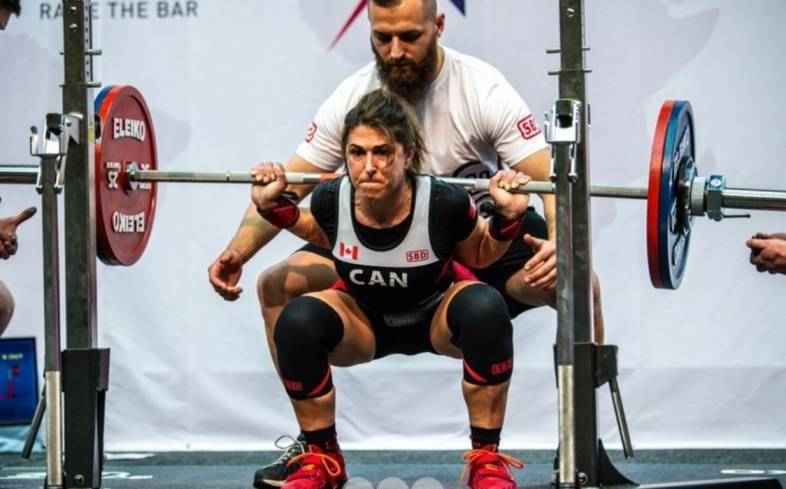
The pursuit of training in order to become a stronger and overall better lifter places intense demands on the body. When it comes to ensuring the health and longevity of your body (including your spine), having a healthcare professional who understands both the nature of your scoliosis AND your desire to stay active with lifting is extremely important.
The more frequently and intensely a car is driven, the more often it needs to be inspected and serviced by a mechanic.
The human body is the same when it comes to how frequently and intensely it is challenged through physical activity. Throw a bit of scoliosis into the mix and you have good reason to make sure you have a professional “mechanic” in your corner who can keep you moving well and lifting for years to come.
Unfortunately, many healthcare professionals have misconceptions or a lack of understanding as to how powerlifting can be incredibly safe and beneficial for an individual when pursued and performed correctly. They may be an exceptional practitioner who unfortunately doesn’t know the true versatility that exists with training in order to optimize the lifting and training process for each individual.
A good healthcare practitioner for your needs will understand the variability you can apply to optimize your training just as well as they understand the full nature of your scoliosis. Thus, they will be supportive of your pursuits while still offering professional insight and therapeutic treatment based on the nature of your condition.
There are many healthcare practitioners out there (physical therapists, chiropractors, osteopaths, etc.) who have a great understanding of what appropriate, individualized powerlifting training looks like. Find one (or more) and add them into your spinal hygiene regimen (discussed below) as best as possible.
This is illustrated exceptionally well in Brian Carroll and Dr. Stuart McGill’s book Gift of Injury: The Strength Athlete’s Guide to Recovering from Back Injury and Winning Again, where powerlifting world-record holder Brian Carroll documents his amazing recovery from a horrific back injury with the help and guidance of Dr. Stuart McGill.
It makes for a great, educational-based read for those looking to understand just how robust the human spine is and what it can recover from and train through with the help of a knowledgeable and supportive healthcare professional.
Get Familiar With Exercise Variations For Each Of The Lifts
While the sport of powerlifting is centered around three different lifts (bench press, squat and deadlift), powerlifting training actually consists of performing numerous variations of each of these lifts as part of the resistance and strength training process.
Each and every one of these exercise variations have a specific purpose in terms of how it contributes to optimizing your strength and/or technique around one of the three primary lifts. Sometimes the movements that they require are only slightly different from the main lift, while other times they can require vastly different movements.
And while each variation contributes to making you a stronger and more technically proficient lifter overall, they all each require slightly different movement patterns for not just your arms and legs, but for your spine as well.
This should be absolute music to your ears since you’re not going to be a painter who is stuck with only using three colours to “paint your strength”, but thousands of color variations to open up a world of training potential that best suits your spine’s needs.
What this means for YOU as a lifter with scoliosis is that you may find certain exercise and movement variations to be more ideal for you than others.
As time goes on in your training pursuits, you need to develop an acute sense of awareness as to which exercise positions, movements and physical demands are more ideal or problematic for your spine. This is the case for any lifter, but especially when dealing with scoliosis.
I recommend starting with these resources:
Examples of Using Lifting Variations
Here are some quick scenarios where it would be advantageous to try lifting variations:
- You may find that low-bar squatting just doesn’t feel very good for the region of your spine that the bar is resting on and you may therefore instead prefer squatting in the high-bar position instead. Neither of these exercises are “right” or “wrong”, rather one is simply more optimal for what your spine can tolerate.
Want to learn more? Check out my article on where you should put the barbell on your back for squats.
- Another example could be that your training calls for conventional deadlifts, however your scoliosis gives you pain or discomfort in your mid or upper back during the movement. Experimenting with variations such as pulling from the sumo position may alleviate the amount of stress or tension that this area of your spine experiences when pulling from the conventional stance.
Read my guide on the differences between conventional vs sumo deadlifting and which one will be more optimal for you.
- You may have a coach or lifting mentor write up a training program for you, only to find that some exercises seem to bother your back no matter how much you pay attention to your form and technique. It’s not that these exercises are wrong or bad and it’s not that your coach doesn’t know what they’re doing, rather that these exercises and their subsequent movements may just not be ideal for what your spine can accept or tolerate. This is where you’ll need to either know or experiment with exercise variations that will allow you to stick closely to the program without causing pain or dysfunction for your back.
Key takeaway: Learning all sorts of exercise variations and which ones feel or work best for you takes time and is a process that every dedicated lifter goes through. The process is invaluable since you will ultimately be rewarded with knowing which exercises your spine prefers when training, which will ensure a lifting career filled with greater longevity and less pain.
Become An Expert On Your Own Spine
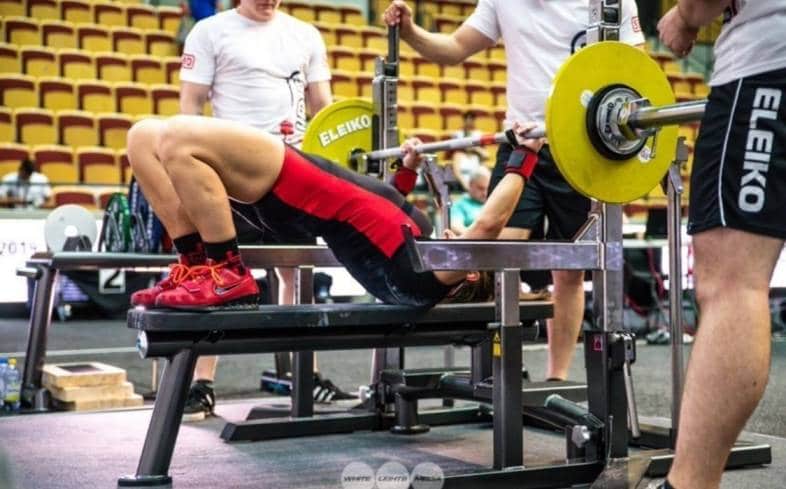
Closely related to the fact that you need to become familiar with variations of training exercises that work for you is the requirement for you to become an expert on your own spine – something that extends far beyond simply knowing exercise variations that either work or don’t work for you.
Truth be told, becoming an expert on one’s own spine is something that every lifter would be wise to pursue. However, as a lifter with scoliosis, it would be prudent of you to be much more in tune with your back than the average lifter (and chances are that if you do this, you’ll have a longer lifting career than many a non-scoliosis lifters).
Here are two ways you can become an expert on your spine:
1. Experiment with Your Set-up Technique and Form If Needed
Lifting technique and form are the foundation for training longevity and success in the world of powerlifting.
Every healthy and successful lifter has taken their time to hone in on and develop their own techniques that work best for them.
As a lifter with scoliosis, you MUST do the same, and in the process realize that your own set-up positions and techniques may look quite similar or perhaps quite different than those utilized by your coaches or fellow lifters.
The extent to which your set-ups and techniques differ all depend on the extent of your scoliosis.
I recommend starting with these resources:
- Best Back Angle For Squats
- Best Back Angle For Deadlifts
- How To Fix A Rounded Back During Squats
- How To Fix A Good-Morning Squat
- How To Fix Leaning Too Far Forward While Squatting
- Proper Breathing Technique For Squats
- How To Fix Hips Shooting Up In The Deadlift
- Is It Okay Deadlifting With A Round Back?
- How To Keep Your Back Straight Deadlifting
2. Experimenting with Set-up Technique
Every successful lift (in the gym or in a competition) begins before the weight is even lifted. Setting up for each lift helps optimize both safety and performance of the lifter.
This is simply due to the fact that the set up positions required for each lift (or variation lift) require the bones of the spine and their subsequent joints (known as the facet joints) to move into (and then be held) in different positions.
As a lifter with scoliosis, your joints likely won’t move in the exact same directions as a normal spine, so it may not be reasonable to think that you can achieve the exact same set-up positions on the lifts as what your peers do or what your coach typically recommends.
Again, this is highly dependent on the extent of your scoliosis and at what level(s) in your spine it is most prominent, but the point is to not necessarily blindly copy other lifter’s set-up techniques or positions when they have a different spinal configuration than yours.
As an example:
- Setting up on the bench press when attempting a competition-style lift requires the lifter to produce maximal amounts of thoracic spine extension (i.e. doing a bench press arch). Scoliotic spines tend to have less ability for accomplishing this type of movement, at least without movement compensations (such as your torso wanting to rotate to one side) due to the alignment of the facet joints.
- You may find an extreme extension of this range of your spine to either be uncomfortable or limited to some degree. You’ll need to be aware of this and simply take time to learn a set-up technique and subsequent bench pressing position that feels appropriate for you. Don’t keep forcing your spine into a position it doesn’t like simply because you're trying to mimic the exact same set-up and positional technique that other fellow lifters are using.
Develop Exceptional Spinal Hygiene
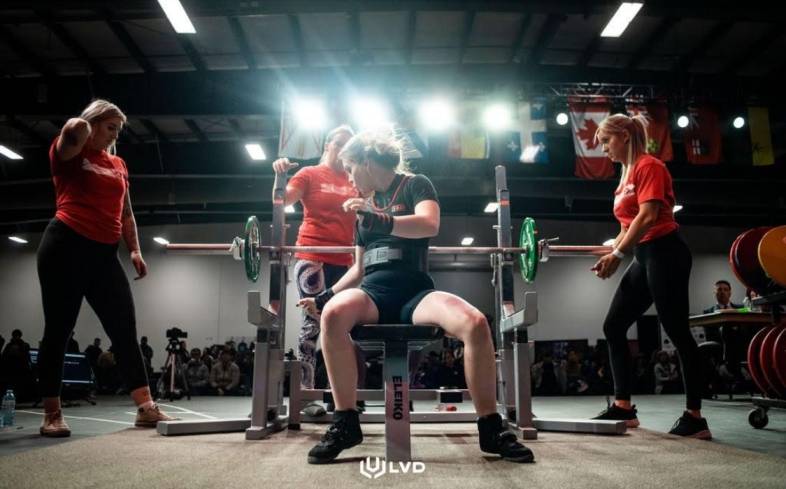
Spinal hygiene is exactly what it sounds like: developing consistent and healthy habits that look after and maintain the health of the various tissues and components that comprise your spine.
Just like good dental hygiene is something that you actively pursue by routine brushing, flossing and going for check ups, your back must be treated with the same extent of focus and care. Prevention is better than any cure.
Each and every lifter (with scoliosis or without) should make regular, dedicated efforts to keeping their spine strong and moving as optimally as possible. Developing a care routine that is as optimized as possible for your own individual spine takes time to achieve, however is beyond well worth it.
Good spinal hygiene should include:
- A dedicated warm up, mobility and muscle activation routine specific to your spine before each training session. This helps ensure proper functioning of the spinal muscles during each training session. Read: How To Warm-Up For Powerlifting.
- A dedicated regimen for ensuring proper strengthening and activation of deep core muscles in order to keep the spinal-stabilizing muscles strong and healthy. Read: Best Core Exercises For Powerlifting.
- Regular or routine maintenance by a dedicated health care professional familiar with your condition who supports your athletic pursuits.
- Making sure that you optimize the mobility, strength, and movement control abilities of your hips (see the following section).
Keep Your Hips Healthy
The hips are to the low back what plates are to a barbell – sure, they’re technically separate entities, however, they’re both so integral that you can’t use one much without the other.
As a lifter with somewhat abnormal spinal alignment, the healthier you can keep your hips, the healthier you will keep your back.
There is a rather direct correlation to this. Hips that are able to operate through normal and equal ranges of motion on both sides, operate with appropriate amounts of strength and that are able to move with appropriate control are your absolute best friend when it comes to maintaining a healthy back.
Take any of these components away and you face a much steeper uphill battle in terms of keeping your back healthy over the long run.
This is due to the fact that if mobility or strength is lacking from one or both of the hip joints, the mobility, the muscle activation and/or dysfunctional movement must then be made up for somewhere else that is nearby. And it just so happens that the nearby joints and muscles are those of the lower back.
Get in the mindset and habit of treating your hips as if they’re a part of your spine, because in a functional sense, they absolutely are.
Keeping your hips healthy was one of my recommendations in my article on How To Avoid A Powerlifting Injury.
Final Thoughts
There is a lot to take into account when it comes to lifting with scoliosis, however, it’s not unheard of to come across a powerlifter (or another athlete) who has this spinal condition yet is able to perform with full functional abilities and no pain.
If you’re looking to get into any form of lifting weights and have this condition, make sure you understand the nature and extent for your scoliosis and remember that an educated approach will yield amazing overall results.
If Usain Bolt can run 100 meters in 9.58 seconds with such a scoliotic curve to his spine, chances are good that you can still pick up a barbell and lift.
About The Author

Jim Wittstrom, PT, DPT, CSCS, Pn1
Jim is a physical therapist, strength & conditioning specialist and former competitive powerlifter. He loves treating lifters and other active individuals in the clinic and working with them in the gym in order to help them move better, feel better and maximize their training potential.
Website: www.strengthresurgence.com
References
2. Aebi M. The adult scoliosis. Eur Spine J. 2005;14(10):925-948.
3. Hensinger RN. Congenital scoliosis: etiology and associations. Spine. 2009;34(17):1745-1750.

